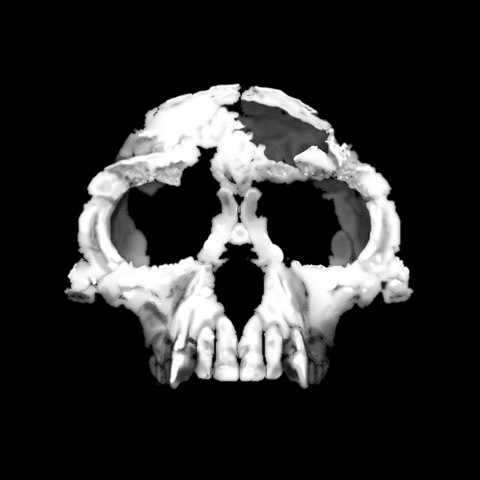 |
| Ardi's skull reconstructed (CC by T. Michael Keesey) |
I recently mentioned that Sahelanthropus tchadiensis 'Toumaï' was quite clearly within the hominini biological tribe, i.e. in the line leading to us and not anymore in the one leading to chimpanzees and bonobos. Now I have to echo the claim that a more recent being, Ardipithecus ramidus 'Ardi' also seems to have skull characteristics that place it in the hominin group.
While the relevance of Toumaï's grouping is much greater, because it help us to clarify the issue of Pan-Homo divergence dates, which seems to be of the order of c. 8-13 million years ago (Langergraber 2012), the case of Ardi is not without interest anyhow in the understanding of human evolution.
From Science News:
By examining 79 skull bases of chimps, gorillas, modern humans and ancient hominids, Kimbel’s group identified relationships among anatomical landmarks that distinguish apes from people and hominids. The researchers estimated the total length of A. ramidus’ skull bottom and found that it fell within a range characteristic of hominids, not apes.
As in more recent members of the Australopithecus genus, such as the 3.2-million-year-old partial skeleton nicknamed Lucy, Ardipithecus ramidus displays a relatively short, humanlike skull base, Kimbel said.
A new 3-D analysis of Ardi’s previously reconstructed pelvis, also presented April 11 at the anthropology meeting, finds a mix of monkey, ape and hominid characteristics. Although not confirming a consistently upright gait, this version of Ardi’s hips doesn’t undermine her proposed hominid status, said Nicole Webb of City University of New York, who led the research.
As for Ardi’s disputed mode of travel, she probably had a two-legged gait “but didn’t use her hands much while upright,” said Caley Orr of Midwestern University in Downers Grove, Ill., who didn’t participate in the new research.
While Ardipithecus ramidus is dated to c. 4.4 Ma BP, there is another specimen of the same genus, Ardipithecus kadabba, dated to c. 5,7 Ma.
Ref. AAPA 2013 meeting (abstracts):
- W. Kimbel et al. Ardipithecus ramidus and the evolution of the human cranial base.
- N. Webb et al. An analysis of the Ardipithecus ramidus pelvis reconstruction using 3D geometric morphometric techniques.
Given the evidence that chimpanzees developed knuckle-walking (and therefor perhaps the propensity for quadrupedality) independently of gorillas, I'm a bit skeptical of that tacit assumption that they are the ones with the ancestral character when it comes to skull orientation. How do gibbons (which are more bipedal than quadrupedal) compare?
ReplyDeleteThe Gorilla and Pan branches separated from ours not too far in time and actually chimpanzees seem to have inherited one chromosome (#12) from the gorilla branch (see here) while for all the rest they are in our branch. So we have two early divergent branches from the Homininae which tend to be quadrupedal (although bonobos much less so).
DeleteRather than with gibbons, which have undergone a radical genome translocation compared to us and other great apes, I'd compare with orangutans maybe.
The best I could find is this 2005 article, which compares the three great apes with A. afarensis. All them but the hominin seem to have a more backwards foramen magnum. So I think we can conclude that the paleoanthropologists are doing their job quite well in this case.
I certainly agree that simple phylogenetic bracketing suggests that quadrupedality is ancestral for great apes, but bracketing isn't always right. In particular, it's interesting that each of the living quadrupedal great ape genera has a different method of walking quadrupedally: fist-walking in Pongo, columnar knuckle-walking in Gorilla, and extended-wrist knuckle-walking in Pan.
DeleteThe evidence I referred to before is here (should have provided that up front, sorry): http://www.pnas.org/content/106/34/14241
Hadn't known about the genome translocation in gibbons -- very interesting.
Is the position of the foramen magnum known for any Miocene pongines?
The article you cite discusses the hands, which would be largely another debate, IMO. Quadrupedalism, even if variable, can also be arboreal, where knuckles play no or limited role. Also all great apes and even many other monkeys can be bipedal to some extent. But humans, and presumably/apparently, their ancestors of the Hominini grouping, have a very marked adaption for land bipedalism (different from arboreal bipedalism) of which a key trait is the foramen magnum, i.e. where the backbone meets the skull. Other traits are the hips, the length of legs, etc. but for that we need to have other evidence than just skulls.
Delete"Is the position of the foramen magnum known for any Miocene pongines?"
When I was searching for the other article, the first images I found were skulls of sivapithecus or gigantopithecus (can't recall). They looked very similar in structure to that of orangutans.
Fair points, I suppose. I like to keep an open mind on the issue for now.
DeleteIf Gigantopithecus, I think most of the better material is Pleistocene. But it's not very close to Pongo within Ponginae, so it's still relevant. The oldest pongine (Ankarapithecus) is known from some partial skulls, but they don't seem to preserve that area. :[
Please do not reply to DDeden: he's banned and his "comments" are obvious trolling nonsense.
ReplyDelete